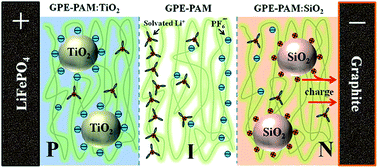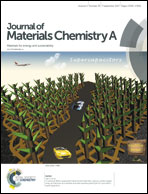Diode-like gel polymer electrolytes for full-cell lithium ion batteries†
Abstract
This study designs a positive–intrinsic–negative (PIN)-diode-like gel polymer electrolyte (GPE) for a full-cell graphite|electrolyte|LiFePO4 lithium ion battery to facilitate interfacial ion transfer at both the anode and cathode. The diode-like GPE comprises an intrinsic poly(acrylonitrile-co-methylacrylate)-hosted electrolyte layer, as well as positive and negative layers that are synthesized by doping the intrinsic layer with TiO2 and SiO2 nanoparticles, which respectively exhibits positive and negative zeta potentials. The positive layer that adsorbs PF6− anions is in contact with the LiFePO4 cathode of the battery to facilitate the transfer of Li+ cations across the interface. The negative layer, which is in contact with the graphite anode, adsorbs Li+ cations to suppress accumulation and prevent the intercalation of solvated Li+ into the graphitic framework. The intrinsic layer acts as a neutralization zone to lower the current-rectification effect of the p–n junction. This PIN-configuration design for electrolytes enhances the ultimate capacity of the full-cell battery, exhibits high rate capacity retention, and increases the lifespan (87% capacity retained after 500 charge–discharge cycles).



 Please wait while we load your content...
Please wait while we load your content...